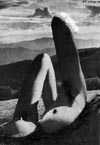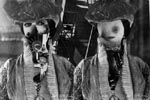 |
Vol 2, No 7
21 February 2000 |
|
|
 K A R E L T E I G E:
K A R E L T E I G E:
Photomontaged Dreams Landscape and the female nude in Teige's collages Mark Hearld Karel Teige exploited the physicality of collage as a medium to superb effect: with scissors and glue he constructs poetic reality as a concrete visual image. Photographic snippets of the real world are extracted from their original contexts and rebuilt into a dreamscape of absurd juxtaposition. Teige's photo-collages have an authority that would be difficult to achieve in painting. He exploits the human belief in the photographic image to make his surreal assemblages plausible on a certain level, as this is important in creating something convincingly imaginary. A meandering road leads the eye through a "green" landscape curving past the gigantic head and shoulder of a woman rising up from the side of the road as a geological feature. Her closed eyes contribute a dozing serenity to the mood of the scene. The woman is generic, she seems emblematic of Mother Earth. Teige poetically fuses landscape and the female form into an image of utopian fertility. As Vojtěch Lahoda says of Teige's vision in a recent essay (1999): "Nature becomes the setting for an 'erotic' composed landscape, a kind of Jungian mother earth. For Teige, this was ultimately to be poetry as life and life as poetry."
This image defines a space with a sense of its own permanence and history, but at the same time the work is escapist. Teige is retreating from the present and the immediate reality of a war-torn Europe into the realms of his own imagination. In defining his own dreamscape, "the resurrected 'composed' landscape now becomes a three-dimensional work of art, the incarnation of a poetic dream, no longer to be merely captured by impressionist landscape painting, which provides only a momentary snapshot of nature. It will be higher, man-willed nature in Hegel's sense: "a humanised nature, which will be a man's organ as well as the work of his soul"
The feathered hat and gowns typify the costume of the bourgeoisie. Teige's assembled women are literally held together by their costumes - a superficial exterior casing which subsumes human substance and spirit. The women's sexuality is blatant and cheap - it becomes a material commodity, something one can buy into. They become mannequins in a shop window selling themselves. The women are physically hollow, their bodies are voids housing disparate bits of machinery.The "women" stand in disturbing symmetry against an industrial backdrop - against a backdrop rather than in an environment. Teige sets the "women" in alienation, they do not inhabit real space or a real world. Even though women, or bits of women, form the basis for all these compositions, the subject matter of the female body is not always the actual theme of his work but rather the raw material, the grammar from which Teige makes lyrical or political or emotional statements. Sometimes, as in collage No 57, woman becomes a vehicle for social critique and also a vehicle for Teige's contempt of the bourgeoisie. At other times Teige projects his ardent desire for the female form onto a landscape. The result is an idealised world - a dreamscape in which Teige could dwell in his own imagination. Mark Hearld, 21 February 2000
|
|
![]()
Copyright © 2000 - Central Europe Review and Internet servis, a.s.
All Rights
Reserved

